
July delivered concrete progress across public chain development and ecosystem partners. CryptoFactor prepared for their August mainnet launch, Sceptre completed final testing for liquid staking, and we finished our annual technical roadmap with community input integrated throughout the process.
The month also brought browser improvements that address specific user pain points, from testnet onboarding to stake visibility.
Here’s what happened in July and what’s coming next.
Crypto Factor’s InterChain protocol entered its final preparation phase. The CFR dApp is completing final integration with the new InterChain operator protocol. Gas optimizations are targeting 20-30% fee reductions from testnet versions.
August plan:
Mainnet beta will be available for registered participants once deployment is complete. Please contact us via official channels to request beta access.
Sceptre completed final preparations for liquid staking launch. All wallet integrations are finished. Final testing is complete. Launch expected soon.
Users will stake MPC tokens and receive sMPC tokens that accumulate staking rewards while remaining liquid for use across other protocols.
“Sceptre will give MPC holders a way to earn staking rewards while keeping a token (sMPC) that allows them to participate in other protocols on Partisia,” says Joel Monteiro, Head of Marketing at Sceptre.
We finished the Annual Technical Roadmap (July 2025–June 2026) in July. Community input was collected, reviewed for technical feasibility, and integrated into development priorities.
Detailed timelines and features will be announced soon.
We awarded Crowdsnap a grant to build a Proof of Humanity solution. AI tools can create fake identities to manipulate surveys. Traditional verification systems expose biometric data or use centralized authorities.
Crowdsnap’s solution uses MPC to generate biometric hashes from speech recognition and facial detection. No single party sees raw biometric information. This verifies human identity without exposing personal data while meeting data protection regulations.
July updates:
Testnet gas distribution: New users on testnet can now get gas automatically. This enhances the developer experience for those testing applications and streamlines the onboarding process for ecosystem builders.
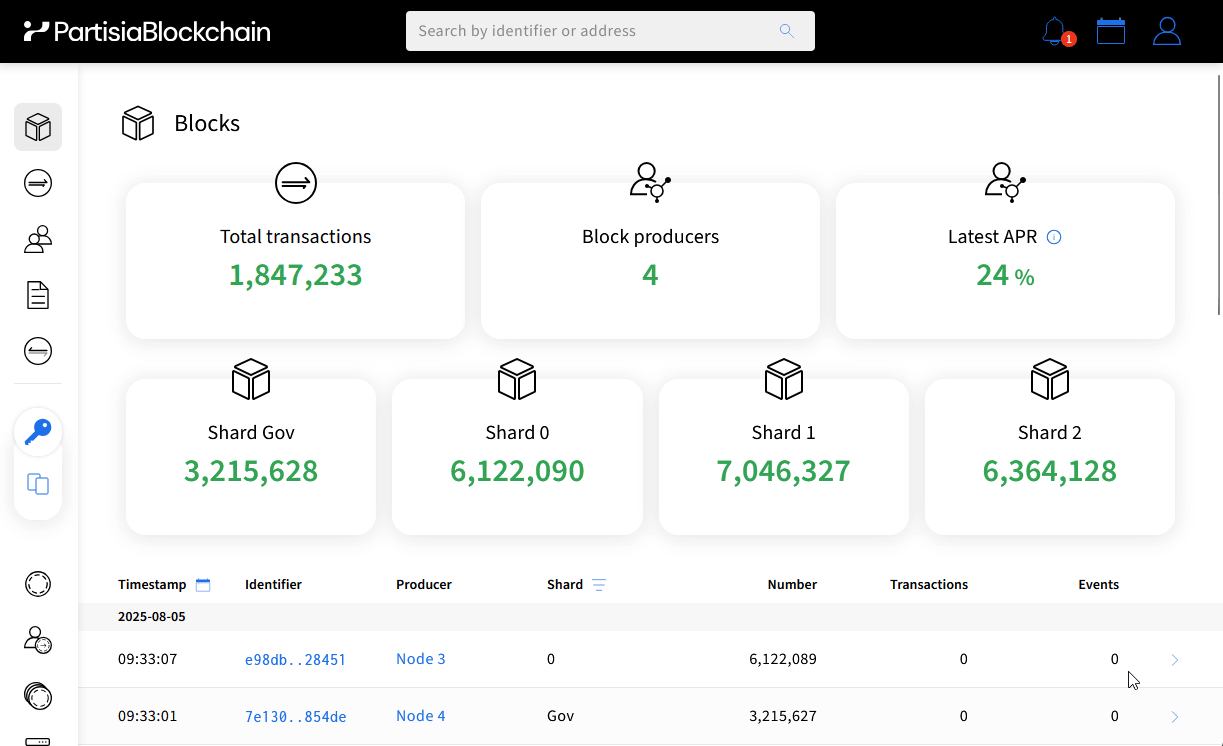
Gas activity fixes: Fixed gas activities showing wrong signage, improved accuracy in transaction history, and fee tracking for better transparency.
UI improvements: Resolved token and gas balance overlapping on small screens, enhancing the mobile browsing experience. Added helpful tooltips for block producer icons on the accounts/node-operators page.

Association spread visibility: Association spread is now shown on the jobs tab, which is part of the broader “Make it easier to understand where stakes are and make it easier to get them released” roadmap task. Additional improvements in this area are planned for the following weeks.
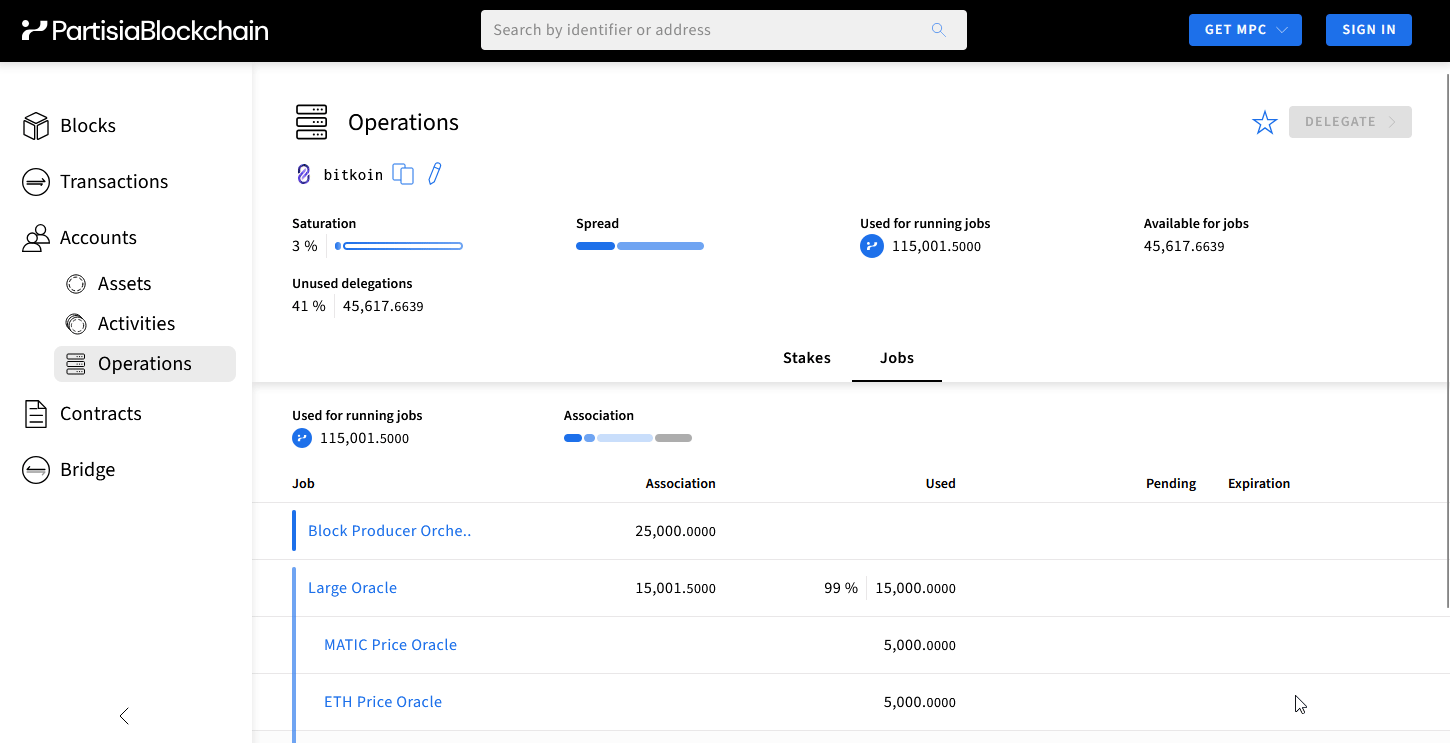
Previous improvements for context:
August:
July showed partners moving from testing to production and infrastructure, addressing user feedback.
Stay updated with the latest developments through our Community Hub . You can also send questions directly to our team by using this form.
Ready to build a more confidential, scalable future?
Join the us at partisiablockchain.com and on X • Discord • Telegram • LinkedIn • Facebook • Instagram • GitLab • Medium • YouTube
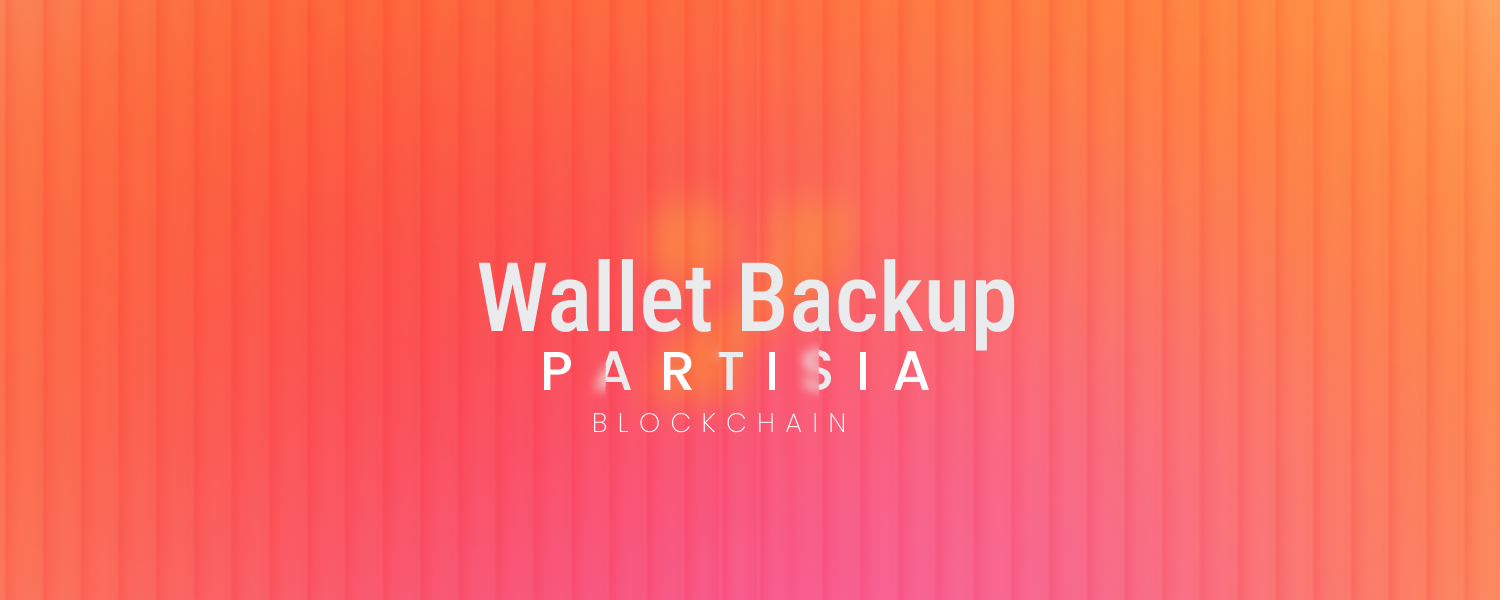
You’ve heard the stories of a lost laptop, a forgotten seed phrase, a wallet left unrecovered with serious funds inside. No one thinks it will happen to them, but it happens every day. And very often, it comes down to one thing: skipping the backup.
This guide is here to help you avoid being the next cautionary tale on Crypto Twitter. Regardless of what wallet you’re using, we’ve got you covered, with clear steps and essential tips to help you back up your wallet the right way. It’s one of the most important things you can do in web3.
In web3, your wallet is more than just a way to store assets. It’s your on-chain identity. It’s your access pass to dApps, protocols, and decision-making.
And in self-custodial environments, that responsibility is amplified. There’s no support line to call. No password reset option. You’re the only one who holds the keys, and the only one who can protect them.
Why It Matters: When you hold your own keys, you’re in control, and solely responsible for access and recovery.
Koala Wallet
Want peace of mind? Back them up now. Test your recovery if you haven’t.
Don’t:
Do:
Pro Tip: If your backup lives on the internet, it’s not a backup. It’s bait.
Even with the best intentions, things go wrong. If you’ve already lost access or want deeper recovery options, these guides and community resources can help:
You’re not just saving a file. You’re practicing sovereignty. Partisia runs on MPC and privacy-enhancing tech because we believe you should control your data and assets. Whether you are signing transactions, running MPC, or interacting with on-chain applications, access starts with your keys, and ends if you lose them.
Backing up your wallet is the most underrated move in crypto. It’s your firewall against regret.
Join the us at partisiablockchain.com and on X • Discord • Telegram • LinkedIn • Facebook • Instagram • GitLab • Medium • YouTube

This month, we’ve got a bonus update, combining both May and April’s developments, which brought meaningful activity across key areas, from builder progress and infrastructure updates to increased visibility and engagement.
Staking rewards are now distributed weekly, a shift from the previous quarterly cycle. The process is now automated, simplifying how rewards are paid moving forward.
zkCross is live on mainnet, with a major upgrade on the way. The upcoming release will introduce a streamlined UI, improved liquidity flows, and built-in migration tools. In the meantime, users can already explore the DEX, including how to add liquidity, swap assets, and navigate the current interface.
→How to Use zkCrossDEX on Partisia: A Step-by-Step Guide to Cross-Chain Swaps
Meanwhile, teams like Sceptre and CrowdSnap continued progressing toward the mainnet and expanded real-world development.
And Messari, one of the most influential research firms in crypto, published a full-length report on what they call Privacy 2.0 and DeCC (Decentralized Confidential Compute), highlighting Partisia Blockchain as a leader in an important evolution within web3, where computation itself becomes private, not just transactions.
Here’s an excerpt from the report: privacy isn’t just about hiding transfers anymore, it’s about making computation confidential by default. MPC, ZK, FHE, and other cryptographic tools are forming the basis for a new layer of infrastructure.
Partisia was featured as the only live L1 using MPC at the base execution layer.
If you’re here, you’re early.
→ Read the report
We also hosted a two-hour community AMA, a wide-ranging session that reflected strong engagement and set the stage for more structured formats ahead.
Speaking of the community. May was also the month of the “catch of the day” sticker. A quick moment in Telegram, where a suspicious alt got called out by a team member, turned into a meme, then a sticker, then a bit of lore. No roadmap required.
→ Not in Telegram yet? That’s where a lot unfolds in real time.
→ Join Our Community
Ecosystem development in May spanned everything from backend architecture to user-facing dApps. Here’s how it breaks down:
→ Strengthening the foundational rails for DeFi, liquidity, and privacy-preserving applications built with MPC.
→ Extending Partisia Blockchain’s utility across networks, assets, and DeFi primitives.
You can support builders by:
– Following them on X: zkCross, Boosty Labs, Sceptre, CryptoFactor, Koala Wallet, CrowdSnap
– Website: zkCross, Boosty Labs, Sceptre, CryptoFactor, Koala Wallet, CrowdSnap
– Sharing and amplifying their work across your own networks
→ May brought changes to Partisia Blockchain staking, browser tools, and node operations, mostly focused on automation, transparency, and better developer control.
Staking rewards are now issued weekly, replacing the previous quarterly cycle. The first round of weekly staking rewards has been distributed, covering Week 144 (ending March 2nd).
The process is automated, no intervention is required from node operators. Rewards are finalized each Sunday, with payout transactions executed by the Partisia team.
Work continues on improving the Partisia Blockchain Browser, with a focus on usability and clarity for everyday users.
Node ops and stakers are seeing expanded tools, from reward automation to manual controls and visibility.
Developer experience (DevEx) continues to mature, with better contract tools and support for more advanced Rust features.
The smart contract playground has also received bug fixes and support for new Rust versions, streamlining everything from concept testing to deployment.
→ In parallel with progress across our builder ecosystem, May also brought enterprise pilots, product delivery for identity protocols, and solutions that support regulatory requirements.
Toppan: A Real-World Digital Identity Pilot Built on Partisia Blockchain
Toppan is a major Japanese multinational with over $10B in annual revenue, and with a long history in security printing, identity systems, and digital infrastructure. They provide ID solutions for both governments and enterprises across Asia and Latin America.
In May, Toppan announced a digital identity pilot in collaboration with Partisia Infrastructure (PI) and Partisia Blockchain (PBC). Launching at Okinawa Institute of Science and Technology Graduate University (OIST), a Japanese university, this June. The pilot aims to deliver privacy-preserving digital student credentials.
What’s Being Built
Students will receive credentials (e.g. enrollment confirmation, qualifications) they can share securely, without exposing sensitive personal data. The design uses zero-knowledge proofs and MPC key management, handled entirely on-chain.
Who’s Doing What
This shows how real services can operate on PBC independently, a model that scales to future adopters.
→ PBC Announcement
→ Toppan Press Release (JP)
idOS is a decentralized identity protocol for managing encrypted data and cross-chain credentials. In May, the team began integrating Partisia’s MPC-based key management into their access layer.
What’s Being Built
Instead of storing data on-chain or relying on static keys, idOS will use MPC to dynamically decrypt only what a user consents to share, and only for the intended app.
Who’s Doing What
Why It Matters
This reflects real product-market fit for decentralized identity, something many DID frameworks have failed to prove. This partnership isn’t limited to technical integration, it places Partisia at the heart of a growing ecosystem for self-sovereign identity. By bringing MPC to the protocol level, Partisia helps make sensitive data programmable, cross-chain, and access-controlled, without depending on centralized storage or key-sharing models.
A new pilot launched in collaboration with TERA Batteries, DuoKey, and Quantum Brand Protection (QBP) is exploring how to meet EU sustainability requirements without disclosing proprietary vendor data.
What’s Being Built
This “Battery Passport” system validates claims (e.g. material origin, recycling compliance) using MPC proofs, keeping internal data private while meeting audit needs.
Who’s Doing What
Why It Matters
It shows how MPC can enable regulatory compliance with enterprise-grade solutions without requiring vendors to expose sensitive competitive information, a key blocker in B2B adoption.
→ A moment of stronger visibility, deeper engagement, and clearer community feedback loops.
Scheduled for one hour, the session ran closer to two, a reflection of the range of questions and engagement across the community.
Hosted by Chief Commercial Officer Yusef Fanous, the AMA brought together:
Topics Discussed
Telegram Moment of Appreciation
A few days before the AMA, a Telegram exchange surfaced an alt account moment, which quickly became the “Catch of the Day” sticker. It got a nod during the AMA, capturing something of the current community rhythm: direct, participatory, and not without humor.
What’s Next
The AMAs will continue, alongside follow-ups, builder sessions, and more structured ways to surface questions and close feedback loops across the ecosystem.
→ All Things Partisia Blockchain AMA Recap
→ Read the Full FAQ Summary on the Community Hub
Messari Research Coverage
Partisia Blockchain was featured in a full-length Messari report on Decentralized Confidential Computing, recognized as the only live L1 using MPC at the base layer.
Toppan Pilot Coverage
The university pilot announcement was picked up by multiple Japanese and Web3 outlets, including Toppan’s own newsroom.
Koala Wallet Integration
Supported by blog coverage and a community campaign around mobile access and wallet features.
Battery Passport Launch
Coverage focused on sustainability tech and MPC compliance, featured across LinkedIn partner networks.
→ Messari Report
→ Toppan Press
→ Koala Wallet Integration
→ Battery Passport Launch
Ready to build a more confidential, scalable future?
Join the us at partisiablockchain.com and on X • Discord • Telegram • LinkedIn • Facebook • Instagram • GitLab • Medium • YouTube

Listen to All Things Partisia Blockchain AMA – 28th May, 2025
No filters. No softballs. Just straight answers.
Partisia Blockchain held its most open and wide-ranging AMA to date. We scheduled one hour. We stayed for two. We had a lot to discuss with the community after all.
Hosted by Chief Commercial Officer, Yusef Fanous, the session brought together voices from across the core team:
— Peter Frandsen, Co-CEO of both Partisia Blockchain Foundation and Partisia Infrastructure
— Mark Bungard, CPO at Partisia Infrastructure
— Mathias Glintborg, Head of Product at PBC
The conversation ranged from serious topics like grants, adoption strategies, long-term funding, to lighter moments, like the community “catch of the day” moment a week prior, useful for alts that are a bit of pain.
Some tough questions and some unexpected moments from a session that was part retrospective, part reset, and all Partisia.
One of the most commonly discussed themes in our community, and a question pre-submitted for the AMA by Hasi, from Crowd Snap, was this:
“PBC is chasing commercial partnerships, which is good. But most of those big companies are too process-oriented, and deliveries are slow. Why not invest in ecosystem builders with fair grants like stablecoins to encourage development?”
It’s a topic that’s come up often, and one we were glad to address.
Mark pointed to the year-long progress with Toppan, a major identity player in Japan, as an example of patient, high-impact engagement. The goal? Scalable, interoperable identity infrastructure that can be adopted across jurisdictions and regulatory frameworks:
Mark emphasized that while the timelines are longer, enterprise adoption comes with durability, and the potential to bridge into regulatory and cross-border conversations where privacy and compliance are critical.
Mathias reassured the community that grants aren’t being ignored; in fact, Partisia has already supported core infrastructure within DeFi:
These efforts, while quieter than enterprise headlines, are a necessary part of the core DeFI infrastructure and help enable incentive opportunities, like liquid staking, LP pools, and future integrations across DeFi protocols.
“We already spoke to some of the major stablecoin providers… Circle, Tether, and others. Many of them would like to mint natively on Partisia Blockchain. That’s a big engagement, it takes time, and it has to make sense.”
Yusef rounded out the segment by explaining that Partisia’s grant strategy is selective by design, to avoid “grant farming”. We achieve that by asking: does it align with our strategy? Does it use MPC? Does it drive real activity on-chain?
“Grants are tricky. There’s a trend in the industry where projects just hunt grants, but they don’t have anything to do with the chain. They just want quick cash. So what we’ve done is shift it towards grants that are aligned. We ask: does it align with our strategy? Does it have an MPC use case? Does it drive on-chain transactions? Is it part of our infrastructure focus? And if the answer is yes, then we look to support.”
He also hinted at a growing preference from some projects for deeper collaboration over surface-level grants: teams coming to Partisia Blockchain not for quick funding, but for access to tech they can’t find anywhere else, like the key management solution we’ve developed with idOS.
Regardless of where the questions began, liquidity, token unlocks or DeFi traction, many naturally converged around a key focus: on-chain activity. The community is eager to track it, contribute to it, and help accelerate it. The team approached this theme head-on. Peter Frandsen put it bluntly:
“If we can’t drive on-chain activity, everything else is irrelevant. That’s the existential risk.”
Community members like Cryptid, FunnyMoney, and Manny voiced concern over the absence of what they called “the basics”: DEX liquidity, real ecosystem usage, and clearer product visibility.
Yusef Fanous acknowledged the sentiment, but offered a clear perspective by stating that we’re not here to fake volume or wash trade tokens just to create an illusion of activity. We’re doing things the right way, real users, real builders, real infrastructure. And when we market, we want the funnel to land somewhere valuable.
Mathias Glintborg then added product context, reminding the community of the improvements already live (to the block explorer, smart contract playground, delegation tools), and upcoming UX upgrades.
Behind the scenes, initiatives are also underway:
In short: things aren’t stalled, they’re staging. With DeFi rails taking shape and real traction in DID and RWA use cases, the groundwork is actively being laid for the next wave of adoption.
The Foundation is actively progressing in the right direction across all fronts.
The energy of this AMA was driven by one thing: a community that showed up with questions, direct feedback, and expectations.
The team engaged openly, sharing updates, answering tough questions, and aligning with the community on what matters most.
Governance and Token Unlocks?
When community members raised the idea of unlocking vested tokens, or putting the decision to a vote, Peter Frandsen clarified the mechanics behind such a move, emphasizing that it’s not up to the Foundation alone. Any fundamental change would need to go through proper governance procedures, reflecting the true ethos of decentralization.
“It’s not the foundation’s decision. It’s up to the network. But yes, there’s a way to create proposals, and we’ll help you navigate that.”
Improved visibility for node ops around how governance proposals can be initiated, and an open door to help route them through the right channels.
For detailed instructions, you can refer to the documentation here.
Feedback Loops Are Being Formalized
Yusef Fanous outlined his approach for community involvement going forward:
He acknowledged that marketing won’t be aggressive until the product layer can fully absorb attention, but also affirmed his commitment to bottom-up communication.
“If there’s feedback, constructive feedback, we’re happy to receive it. It doesn’t mean it’ll be implemented immediately, but we’ll pass it through the right teams.”
And yes, about that sticker…
A nod to a former contributor whose questionable sock-puppeting was caught mid-chat by Yusef, and immortalized in sticker form.
This AMA wasn’t just a Q&A, it was a long-overdue signal of a shift in approach. A moment that reflected what many in the community have been asking for: open dialogue, honest feedback, and shared direction across the ecosystem.
An inflection point, and the start of doing more of this, together.
The topics ranged wide: tokenomics, privacy education, DEX liquidity, and long-term sustainability. But throughout, the message from the team was consistent: we’ve heard you, and we’re acting.
Community builder projects like CryptoFactor and CrowdSnap took the mic to share what they’ve been working on:
Both projects expressed excitement about the progress being made, highlighting smoother tooling, growing support, and their eagerness to launch products into the Partisia ecosystem. Now it’s over to the community. You can support builders by:
Early traction is a team effort, and your support makes a difference.
Why hasn’t the team launched a DEX themselves? Why not market more aggressively now?
Peter Frandsen and Mark Bungard were clear: regulatory and compliance constraints matter, especially from Europe.
“Deploying a DEX isn’t just a tech decision. It’s a regulatory one. And yes, we’re working with external entities who can move faster in the right jurisdictions.”
Yusef Fanous addressed the recurring call for bigger marketing efforts, framing it around timing and infrastructure:
“Even the best campaign won’t land if the funnel leads nowhere. Our job is to build the surface area first, so when we amplify, it converts. That means focusing on the product and use cases first, but it doesn’t mean staying quiet. In parallel, we’re actively investing in community engagement, co-marketing with partners, and content creation across channels.”
For anyone who tuned into the full two hours, or even just read this far, it’s clear: this AMA marked a shift. Not just in tone, but in how Partisia Blockchain engages with the very people helping build it, our community, our node ops, our early believers.
The conversations weren’t always easy. That’s the point. Real questions were asked. Straight answers were given. And in between memes, critiques, and clarifications, we are building a better environment for a stronger community.
We’re not just building tech. We’re building alignment.
Missed the AMA? You can still catch up here! Stay connected for follow-up content, community workshops, and yes, more stickers.
💬 Still have questions?
We’ve compiled a full FAQ covering every community question from the AMA.
You can find it here on the Community Hub.
Ready to build a more confidential, scalable future?
Join the us at partisiablockchain.com and on X • Discord • Telegram • LinkedIn • Facebook • Instagram • GitLab • Medium • YouTube

Digital identity (DID) has been a perennial weak link in Web3. Password‑less log‑ins, privacy‑by‑design, and strict compliance frameworks (GDPR, MiCA) have each begun to be solved in isolation, but never together. The idOS and Partisia partnership changes that.
idOS is a chain-agnostic, user-controlled decentralized identity system; Partisia Blockchain supplies a production‑hardened MPC layer that shards and safeguards every private key.
The result is the first fully open, zero‑custody identity stack able to scale from indie dApps to enterprise‑grade deployments.
Thanks to Partisia’s key abstraction, users can manage their idOS data securely without having to download new identity wallet software or remember a password; a simple signature with their wallet of choice will suffice. Partisia will be implemented as a native module within the idOS Storage Network, the L1 blockchain at the heart of idOS. Partisia struck the right balance of security, flexibility, and cost-effectiveness compared to other TSS-MPC providers, and we benefit from their collective decades of cryptography research and implementation leadership.”
Ben Basche, idOS CPO
Millions of wallets, hundreds of blockchains, and still the same awkward dance: copy a seed phrase, re‑upload documents, hope nothing gets lost. Web3 has delivered on transparency but fallen short on reusable privacy‑preserving identity. Every attempt so far has had to juggle three goals that rarely align:
Most solutions pick two and leave a gap. idOS covers usability and compliance, but securing the underlying keys, without adding a central custodian, remained unsolved. That is where Partisia’s fifteen‑year battle‑tested Multi‑Party Computation (MPC) fits in.
idOS is backed and governed by the idOS Consortium, including leading web3 projects like NEAR, Ripple, Arbitrum, and Circle, and serves as the identity layer for apps across multiple chains. Its modular SDK enables developers to integrate reusable, verifiable credentials, streamlining data access management for apps.
Users control their data by granting access via wallet signatures. Credentials are encrypted, reusable, and shared across apps with minimal friction.
Partisia Blockchain brings a production‑grade MPC engine. In practice, it slices every private key into cryptographic shards and distributes them across independent validator nodes. No shard, on its own or in any minority coalition, reveals anything useful. The key is only re-assembled in memory for milliseconds, under quorum, and never lives in a single place.
The net result is the first identity network where:
Traditional custody stores an encrypted key on a server. Lose the server, lose the key.
MPC treats the key like a jigsaw puzzle:
Because Partisia designed its public blockchain around MPC from day one, latency stays low enough for real‑time authentication, a critical point for consumer dApps.
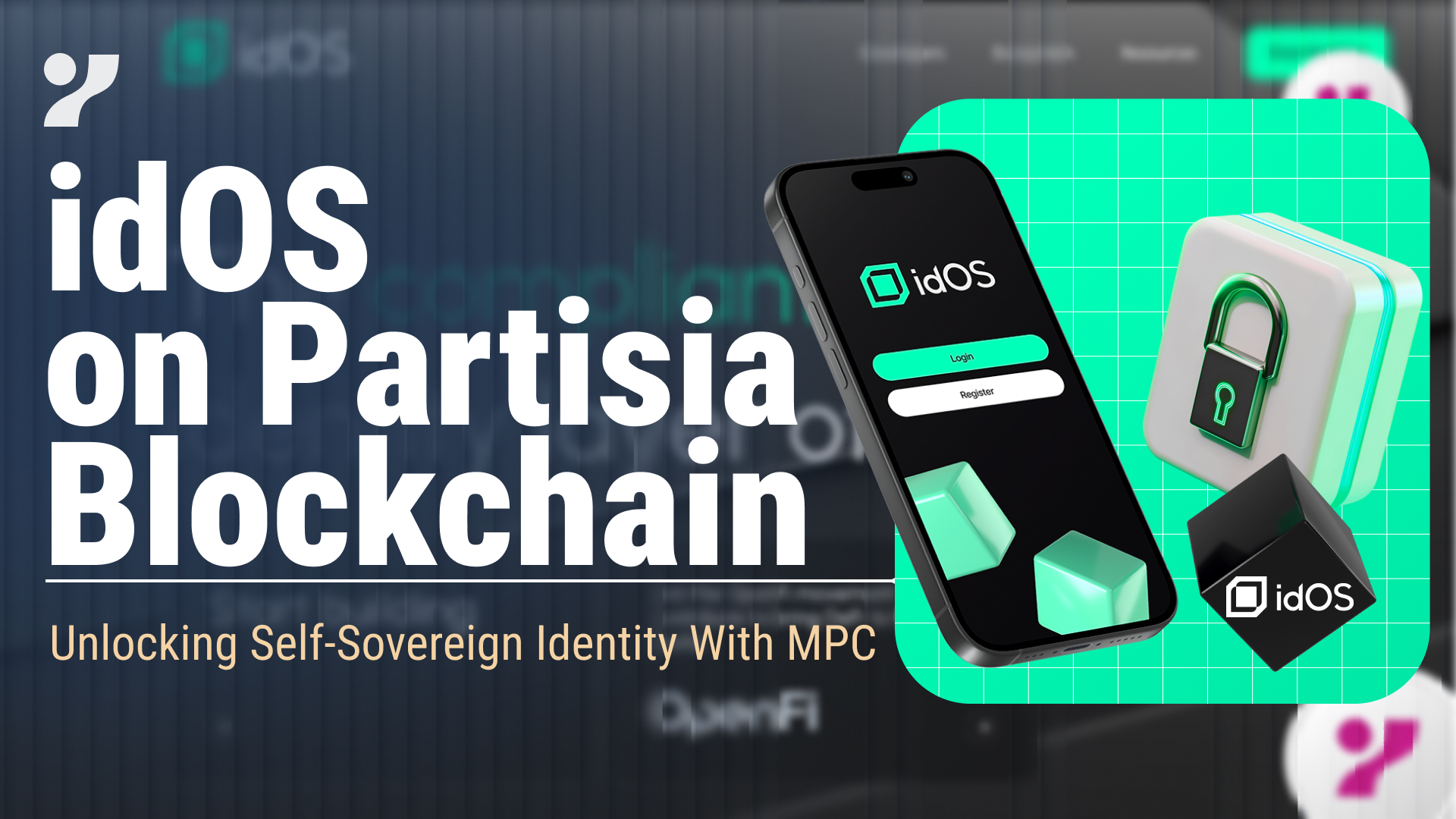
Early pilots with consortium members will stress‑test the stack this summer; public onboarding is slated for Q4 2025.
Once the heavy cryptography is in place, new primitives become trivial, particularly with developments like GODS Network:
Each layer compounds the previous one, nudging web3 closer to a world where identity is flexible and composable, not captive or confined to any single ecosystem
Closed beta with consortium dApps is expected in Q3 2025. This will be followed by the release of the public SDK and docs in Q4 2025 as the early pilots begin stress testing the solution.
For years, decentralised identity talked about self‑sovereignty while leaning on centralised key stores or fragile seed phrases. By merging idOS’s user‑friendly credential system with Partisia’s production‑proven MPC, the partnership turns that rhetoric into concrete infrastructure—one that developers can call with a few lines of code, and that users never need to think about.
If the launch delivers on its roadmap, the bigger win isn’t just safer logins; it’s laying a cryptographic foundation sturdy enough to let identity and privacy finally scale together.
idOS is a decentralized, chain-agnostic identity layer designed to give users control over their data. It allows individuals to create, own, and manage verifiable credentials that can be reused across blockchains and dApps. With privacy and security as core principles, idOS ensures sensitive information stays encrypted and in the user’s control. Developers and enterprises can access compliant identity solutions while minimizing friction and simplifying integration with their modular SDK.
Partisia Blockchain is an innovative data ownership and privacy-preserving layer-1 blockchain built for real-world utility. Combining zero-knowledge proofs and secure multi-party computation (MPC), it empowers developers and enterprises to build decentralized applications with data privacy at the core. From RWAs and digital identity to supply chain and AI, Partisia is driving the next generation of blockchain use cases across web2 and web3 industries.
Our partner announcement can be found here.
Ready to build a more confidential, scalable future?
Join the us at partisiablockchain.com and on X • Discord • Telegram • LinkedIn • Facebook • Instagram • GitLab • Medium • YouTube

Pioneering a New Era of Trusted, User-Centric Digital Identity
Tokyo, April 2025 – In a world where identity is the gateway to education, work, and daily life, the need for secure, user-controlled, and globally trusted solutions has never been greater. This is magnified by a world that is becoming increasingly more connected and digital. Today, TOPPAN Edge and Partisia announce a groundbreaking partnership and proof-of-concept at the Okinawa Institute of Science and Technology (OIST), aiming to redefine how digital identity works for students. This solution is a bedrock for digital identity, with applications that can span industries and use cases.
This collaboration is more than a technical integration. It’s a shared vision to bridge the familiar convenience of web2 with the trust, privacy, and interoperability of web3. By combining TOPPAN Edge’s 100+ years’ experience, including a 33% market share in Japanese ID systems, with Partisia’s advanced cryptography and blockchain solutions, the partnership is setting a new standard for privacy-first, decentralized, digital identity (DID).
Japan alone has over 813 universities, 360 of which issue IDs with IC chips (FeliCa). This involves a process that is costly, slow, and increasingly vulnerable to impersonation and fraud. Meanwhile, students already carry NFC-enabled smartphones and are accustomed to seamless, app-based, digital experiences. The challenge is to deliver a digital identity solution that is as easy to use as a tap on your phone, but as secure and private as the most advanced cryptography can provide.
At the same time, global standards are rising. The EU’s eIDAS 2.0 and Japan’s Trusted Web initiative demand solutions that are not only secure and user-centric but also interoperable across borders and compliant with the latest privacy regulations. The answer lies in a hybrid approach: leveraging the best of web2 user experience and web3’s decentralized trust infrastructure.
The OIST pilot brings together the strengths of both partners in a layered, future-proof architecture:
This hybrid model ensures that universities can adopt the system with minimal disruption, while students benefit from privacy, security, and convenience.
A key innovation of this project is the clear division of roles between Partisia Infrastructure (PI) and Partisia Blockchain (PBC):
This architecture not only future-proofs the solution but also positions it for mass adoption, both in Japan and globally.
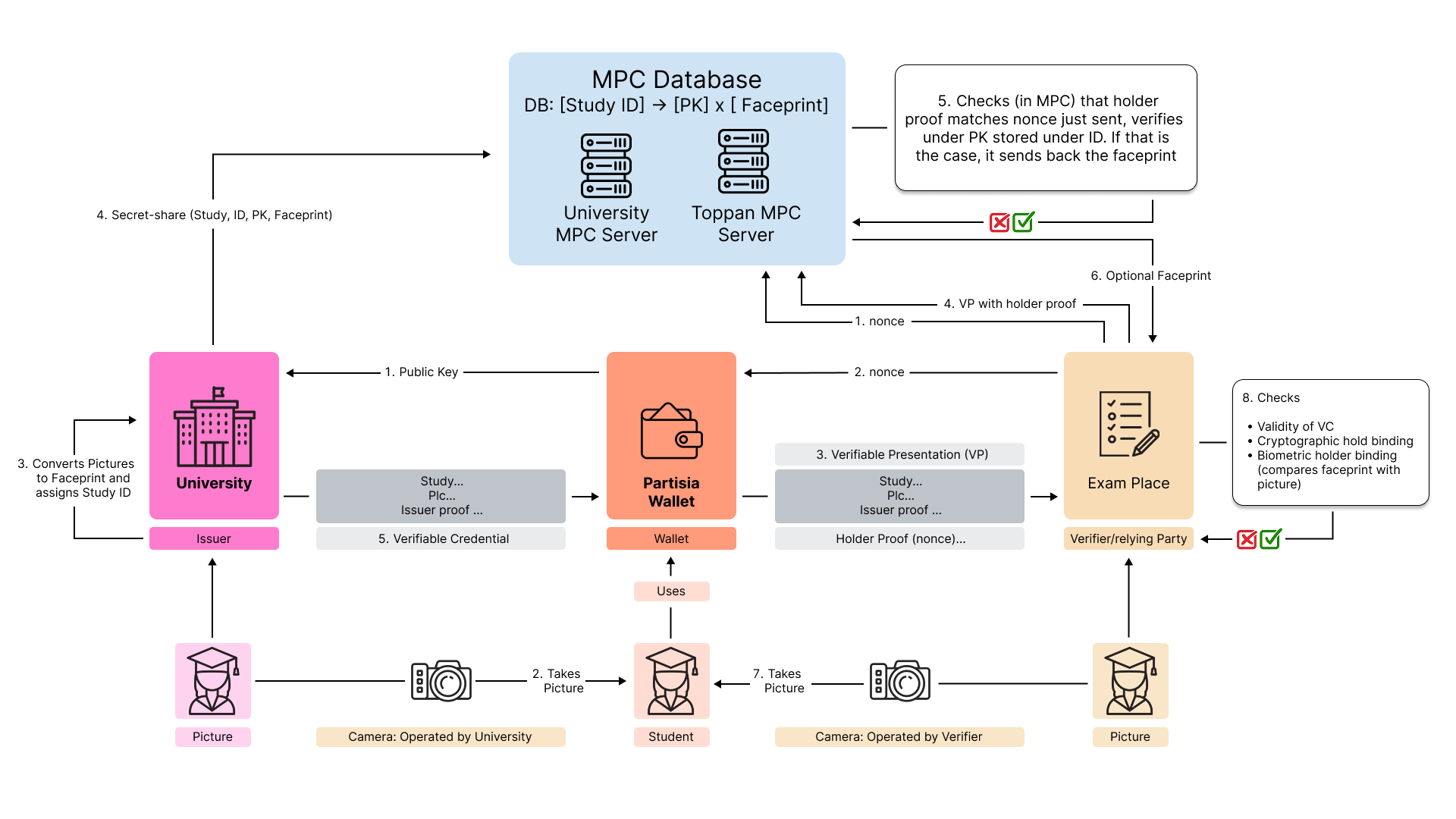
From June to September 2025, the pilot at OIST will involve up to 50 participants from the incubator facility. While the immediate focus is on access control within a university setting, the broader goal is to lay the groundwork for a scalable, privacy-first digital identity infrastructure.
This proof of concept begins with private issuance and verification to ensure the system functions seamlessly in a controlled environment. It then progresses to integration with Partisia’s public blockchain, the release of a public-facing wallet, and the deployment of an on-chain credential registry.
Crucially, this pilot is not the end state. It’s a critical foundation. The architecture being tested is designed to evolve beyond student IDs and campus access, opening the door to applications in IoT, payment infrastructure, and digital identity systems for employers, healthcare, and beyond. By anchoring this work to the Partisia blockchain, this collaboration supports the long-term goals of Japan’s Trusted Web initiative, offering a decentralized, interoperable solution where user control and privacy are built in from the start.
Key performance indicators include sub-second check-in times, zero false-accepts, and full compliance with GDPR and eIDAS audit requirements. The success of the pilot will be a critical first step in building the next generation of secure, user-centric identity systems.
The potential of this platform extends far beyond student IDs. Future applications include:
By anchoring these use cases on a public blockchain, the solution ensures interoperability, transparency, and long-term trust.
As the ecosystem grows, the Partisia blockchain will play an increasingly vital role in securing and governing digital identities. While the initial focus is on establishing a robust and user-friendly platform, future iterations may include:
These features will not only enhance the utility of Partisia blockchain but also create new opportunities for innovation and value creation.
“By fusing TOPPAN’s proven access-control hardware with Partisia’s privacy tech, we’re making the jump from Web2 convenience to Web3 trust, and setting a new global benchmark.”
Mark Medum Bundgaard, Chief Product Officer, Partisia
“This collaboration lays the foundation for a new data economy where confidential student data can finally be activated without ever being exposed.”
Kurt Nielsen, CEO & Co-founder, Partisia Blockchain
“Japan is embracing blockchain to make identity both secure and user-centric. With Partisia, privacy is built-in from day one.”
Masatoshi Oka, General Manager, ID Business Management Division, TOPPAN Edge
Building on the outcomes of the OIST pilot, the roadmap for this collaboration intends on exploring:
Institutions, developers, and regulators interested in early collaboration can find out more from our presentation at the European Identity & Cloud Conference on May 6, 2025, in Berlin.
TOPPAN Edge is a group company of TOPPAN Holdings, established in Tokyo in 1900. As a leader in digital transformation, security, and integrated solutions, TOPPAN Edge is dedicated to solving corporate and social challenges with cutting-edge approaches, including Hybrid-BPO® and advanced payment services. With a 33% market share in Japanese ID systems, TOPPAN Edge is uniquely positioned to drive the adoption of privacy-first digital identity solutions.
Partisia is a Denmark-based pioneer in privacy-preserving blockchain and secure multi-party computation (MPC). Founded by world leaders in cryptography, Partisia launched the world’s first commercial MPC solution in 2008 and now empowers enterprises and developers to build decentralized applications with privacy at their core.
Privacy isn’t an add-on; it’s in the protocol. Join us as we bring user-centric identity to every corner of the internet.
Partisia Blockchain is an innovative, public, data ownership and privacy-preserving layer-1 blockchain built for real-world utility. Combining zero-knowledge proofs and secure multi-party computation (MPC), it empowers developers and enterprises to build decentralized applications with data privacy at the core. From RWAs and digital identity to supply chain and AI, Partisia is driving the next generation of blockchain use cases across web2 and web3 industries.
Announcements can be found from our partners at Toppan and Partisia below.
Ready to build a more confidential, scalable future?
Join the us at partisiablockchain.com and on X • Discord • Telegram • LinkedIn • Facebook • Instagram • GitLab • Medium • YouTube
At Partisia Blockchain, our commitment to continuous innovation drives us to enhance usability, security, and adoption. Our latest technical update delivers four key upgrades outlined in our H1 2025 technical roadmap, reinforcing the foundation for greater scalability, developer flexibility, and a seamless user experience.
These upgrades enhance transparency, efficiency, and developer tooling, strengthening DeFi, enterprise adoption, and beyond.
Read on to learn more about these upgrades, along with some additional exciting elements of our roadmap planned for the coming months.
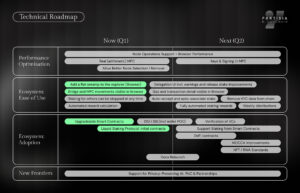
As part of our H1 2025 Technical Roadmap, the following upgrades have now been completed:
Let’s dive into each of these to understand what they mean for users and developers.
Status: Live in Phase 1
Why It Matters: Enhanced transparency & usability
One of the biggest UX improvements for Partisia Blockchain users is the ability to track BYOC (Bring Your Own Coin) movements directly in the Browser.
Key Benefits:
Explore the Update:
What’s Next?
Status: Fully integrated with API Key support
Why It Matters: Seamless fiat-to-crypto access
The integration of Transak into Partisia’s Browser Explorer is a big step toward simplifying onboarding into the Partisia Blockchain ecosystem. Users can now buy MPC directly with fiat, without needing external tools!
How It Works:
Try it out here:
What’s Next?
Status: Open-sourced for the ecosystem
Why It Matters: Flexible staking, improved liquidity
Liquid staking allows users to stake their assets while maintaining liquidity, a feature that has become a standard in DeFi. With this open-source release, developers and ecosystem contributors can now integrate liquid staking into their applications!
Key Benefits:
Want to view the Liquid Staking Contracts? Click here to check out the repo.
What’s Next?
Status: Implemented
Why It Matters: Security, flexibility and long-term usability
While upgradable smart contracts have become an industry standard and critical component in modern blockchains, their addition to Partisia Blockchain unlocks significant improvements for developers and enterprises.
Key Benefits:
What’s Next?
These four enhancements mark a key leap forward in making the Partisia Blockchain ecosystem more accessible, transparent and developer-friendly.
But, this is just the start. In the coming months, we’re rolling out even more game-changing upgrades to push privacy, performance, and usability to the next level:
But, there’s more. Below are a few more items on the roadmap that we’re extremely excited about:
What is it?
Traditional privacy solutions slow things down – but with Real MPC Arithmetic, speed and privacy no longer need to be a trade-off. Building upon our core MPC technology, this advancement enables faster and more efficient secure computations.
Why you should be paying attention!
Think real-time encrypted DeFi, faster private swaps, and scalable enterprise blockchain solutions – all without sacrificing privacy.
What is it?
What if AI could analyze your sensitive data – without ever exposing it? This component of the roadmap will integrate privacy-enhancing mechanisms into AI, allowing for applications that conduct data analysis and machine learning without compromising data confidentiality.
Why you should be paying attention!
Get ready for AI with trustless privacy – keeping data confidential while still allowing AI-powered automation.
What is it?
Imagine a world where you control your identity – without centralized databases tracking your data. DID empowers users with self-sovereign identity solutions and secure key management, enhancing privacy, security and usability.
Why you should be paying attention!
Privacy-preserving, flexible, and built for a decentralized internet. Exciting!
These upcoming features will redefine blockchain privacy, security, and AI-driven trustless automation.
Join us on this journey – make sure to follow us on social platforms and join our extremely passionate community over on Telegram and Discord.
Stay updated: Website • X • Discord • Telegram • LinkedIn • Facebook • Instagram • GitLab • Medium • YouTube
Last week, we shared our updated technical roadmap update on X. As we kick off 2025, Partisia Blockchain is reaffirming its mission to redefine data privacy, scalability, and usability in the Web3 ecosystem.
The upcoming months are packed with transformative advancements aimed at solving real-world challenges and bringing us closer to a scalable, privacy-centric blockchain future.
Today, we’re excited to present a detailed look at the key updates shaping H1 2025 and their impact on our community and beyond.
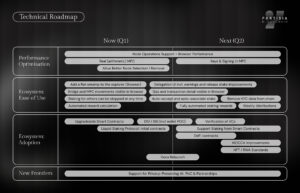
At the heart of Partisia Blockchain is Multi-Party Computation (MPC), and with real MPC arithmetic, we’re delivering faster and more efficient secure computations for real-world applications like AI and DeFi. This critical update brings:
By leveraging arithmetic computations alongside binary computations, Partisia Blockchain offers optimal performance tailored to diverse use cases. This opens up broader possibilities, including near-real-time applications in healthcare and finance.
The integration of privacy-preserving AI into the Partisia Blockchain is a transformative step for AI-driven web3 applications. By leveraging MPC, we’re enabling:
This advancement expands AI’s role in sensitive sectors, providing a secure foundation for innovation where data privacy is paramount.
To simplify onboarding, we’re introducing fiat onramps via the Partisia Browser. This feature addresses key user pain points by enabling:
This improvement opens up Partisia Blockchain to a broader audience, encouraging more individuals and businesses to participate in the network.
The updated staking framework simplifies stake management. Key improvements include:
By making staking easier and more efficient, these updates strengthen the Partisia community and encourage active participation in the governance and security of the network.
As we enhance privacy and usability, Decentralized Identity (DID) and secure key management are critical components of our roadmap. These tools empower users and businesses with:
Partisia Blockchain will take the existing DID and key management solutions and go beyond what current solutions provide using MPC. From customizable presentation using multiple verified credential issuers to flexible key management solutions to provide auditability and robust governance tools, we will aim to bring solutions that truly can tackle real world problems in industries such as healthcare, finance, and supply chain management.
We’re introducing upgradable smart contracts to provide flexibility and adaptability for developers. These contracts will allow:
This development ensures that applications on Partisia Blockchain remain adaptable, reliable, and future-proof, even as industry demands evolve.
Traditionally, businesses and individuals have had to choose between collaboration and privacy. Partisia Blockchain’s advancements eliminate this trade-off by enabling:
These updates collectively ensure that industries, entities and individuals can operate with both security and transparency, creating trust while fostering innovation
Each update plays a vital role in driving impactful use cases across industries, such as:
With the inclusion of DID and key management, Partisia Blockchain strengthens its ecosystem by empowering users to:
H1 2025 is just the beginning. These advancements address many immediate challenges whilst also laying the groundwork for broader, long-term goals in H2 2025, including:
Stay tuned as we work toward building a scalable, secure, and privacy-first future where you own your data and make the rules.
Stay updated: Website • X • Discord • Telegram • LinkedIn • Facebook • Instagram • GitLab • Medium • YouTube
AI and blockchain – two of the most transformative technologies of our time – are converging to reshape how we interact with digital systems. At the forefront of this are AI agents: autonomous entities capable of performing actions in both Web2 and Web3 ecosystems without human intervention. Together, they can rewrite the rules of what’s possible.
Imagine this: An AI agent autonomously moderating content on decentralized social platforms, or collaborating with researchers globally, securely training on anonymized medical data to uncover patterns and suggest treatments for rare diseases – all while keeping patient privacy intact. Or an agent in DeFi, working tirelessly to rebalance portfolios and optimize liquidity based on real-time market trends. These are some of the realities that AI agents are beginning to make possible.
But these breakthroughs don’t come without challenges. Privacy concerns, computational limitations, and trust issues loom large before greater adoption of AI agents. Partisia Blockchain is tackling these obstacles head-on, using its cutting-edge Secure Multi-Party Computation (MPC) technology to pave the way for secure, scalable, and private AI agents.
AI agents are uniquely suited to Web3, where they can act autonomously within decentralized, trustless ecosystems to deliver transformative benefits. Here are some of them:
AI agents can securely train on encrypted datasets without revealing sensitive information. This capability supports applications like:
AI agents can monitor market trends, execute trades, and manage liquidity pools—operating 24/7 to maximize efficiency without human oversight.
AI agents autonomously moderate content and curate user experiences in decentralized communities. For example, an AI agent identifies and flags harmful content for community review, ensuring fair moderation without centralized oversight.
AI agents autonomously moderate content and curate user experiences on decentralized social platforms. For example, an AI agent identifies and flags harmful content for community review, ensuring fair moderation without centralized oversight.
DAO participation is often a challenge as significant amounts of users fail to participate in the governance of projects. AI agents can act as intelligent advisors or representatives in DAOs, simplifying governance. For example, an agent summarizes DAO proposals and recommends votes based on a member’s goals and historical decisions.
In Web3 gaming, AI agents enhance user experiences by acting as intelligent NPCs or personalized assistants, tailoring gameplay to individual preferences.
These opportunities highlight the transformative potential of AI agents. But their success depends on solving critical challenges:
To function effectively, AI agents require access to large datasets, which raises privacy concerns around sensitive information like financial records or medical histories. Robust privacy-enhancing technologies are essential.
Many current AI systems rely on centralized infrastructures, introducing single points of failure and security vulnerabilities.
AI computations are resource-intensive, and traditional blockchain networks often struggle to handle these workloads efficiently, resulting in high costs and congestion.
Users need confidence that AI agents are operating fairly and securely. Transparency is key, but it must coexist with strong privacy protections.
Partisia Blockchain is pioneering solutions that address these challenges, leveraging its privacy-first infrastructure and cutting-edge MPC technology to enable AI agents to thrive in Web3 ecosystems:
Partisia’s MPC technology allows AI agents to train on encrypted datasets without ever exposing sensitive data.
Partisia Blockchain’s decentralized node network eliminates reliance on centralized servers, ensuring AI agents operate autonomously within trustless environments.
Advanced sharding and real-time finalization enable Partisia Blockchain to handle even the most resource-intensive AI computations.
Partisia’s cryptographic protocols ensure that AI agents operate without bias while maintaining data confidentiality, building trust among users and developers.
Partisia Blockchain offers a uniquely robust foundation for AI agents in Web3:
AI agents are poised to redefine decentralized systems, bringing intelligence, automation, and adaptability to Web3. Their success, however, depends on the right infrastructure – one that prioritizes privacy, scalability, and trust.
With its innovative Secure MPC technology, Partisia Blockchain is building this foundation. Together, we can realize the promise of AI agents: smarter systems that respect privacy, foster collaboration, and empower innovation.
Be part of this journey – join our community on Telegram and help shape the future of AI agents in web3.
Stay updated: Website • X • Discord • Telegram • LinkedIn • Facebook • Instagram • GitLab • Medium • YouTube
The 12 Days of Shipmas celebrated the milestones and advancements of the Partisia Blockchain ecosystem while showcasing its commitment to fostering innovation through strategic grant initiatives. These announcements highlighted advancements in privacy-preserving computation and real-world applications designed to empower developers, enterprises, and users alike.
Among the most significant announcements were four major grants that underscore Partisia Blockchain’s dedication to driving ecosystem growth and solving critical challenges in identity verification, document sharing, real estate management, and cross-chain interoperability.
Let’s delve into the transformative potential of these grants, exploring how they leverage Partisia Blockchain’s cutting-edge technology to deliver meaningful value to businesses, developers, and end-users. And if you missed any of the 12 Days of Shipmas announcements, check out our recap article here.
Interoperability remains one of the most significant challenges in blockchain today. Partisia Blockchain has taken an important step toward solving this with Crypto Factor’s Interchain Gateway. This grant supports the development of a secure, decentralized cross-chain gateway that connects DeFiChain and Polygon, leveraging Partisia Blockchain’s ZK (Zero-Knowledge) attestation services and decentralized storage solutions.
The Interchain Gateway is designed to establish seamless connectivity between chains, providing a robust foundation for future DeFi applications. Phase 0, funded by this grant, focuses on operational costs for deploying and managing this connection. The gateway itself operates as a blockchain and uses decentralized storage on Partisia, showcasing an innovative architecture designed for secure, scalable, and efficient interoperability.
This development lays the groundwork for broader ambitions, such as porting Crypto Factor’s dApps and services to new networks. While these initiatives are still under discussion, the initial focus is on creating a solid bridge that facilitates DeFi connections between chains. By providing a decentralized and transparent foundation, Crypto Factor’s Interchain Gateway positions Partisia Blockchain as a vital link in the growing multi-chain DeFi ecosystem.
For developers and users, this gateway unlocks new opportunities to connect ecosystems, providing efficient, secure, and decentralized cross-chain functionality. This integration highlights the collaborative potential of Partisia Blockchain’s technology while building the necessary infrastructure to drive DeFi innovation and adoption.
In today’s digital-first world, identity verification is a constant balancing act between privacy and regulatory compliance. KYC (Know Your Customer) processes often force businesses to compromise on one or the other. This trade-off is particularly significant in Web3, where privacy-first solutions are essential as regulatory frameworks continue to evolve.
Synaps, with support from this grant, is tackling these challenges head-on by creating a privacy-enhanced, on-chain KYC framework powered by Partisia Blockchain’s advanced MPC (Multi-Party Computation) technology. This solution ensures that sensitive user information remains encrypted and private, allowing businesses to meet compliance requirements without compromising data security. It represents a pragmatic approach that safeguards privacy for 99% of users while enabling entities to stay compliant.
By leveraging Partisia Blockchain’s MOCCA framework for key management, Synaps decentralizes encryption keys through threshold cryptography, reducing the risk of breaches. The framework introduces advanced security measures, including key rotation and DAO-based governance for managing authorized signatories. These features ensure that access to sensitive information is both decentralized and transparent. Synaps also plans to use Partisia Blockchain to publish “stamps” as decentralized attestations that verify a user’s successful KYC without exposing personal data.
This innovation solves critical pain points for businesses and users alike. For businesses, it offers seamless regulatory compliance without the liability of storing sensitive data, reducing the risk of breaches and addressing growing regulatory demands like the Travel Rule. For users, it provides greater control over their data, eliminating redundant submissions and creating a smoother onboarding experience.
The potential applications for Synaps’ solution extend across industries. In finance, it bridges the compliance gap, paving the way for onboarding retail and institutional players, including TradFi entities like PrivadoID, Circle, and Fireblocks. In gaming, it facilitates seamless age verification while ensuring compliance for virtual economy management. In healthcare, it enables secure patient identity management, safeguarding data while creating opportunities for personalized services.
Notably, Synaps’ solution aligns perfectly with the rise of AI agents in decentralized ecosystems. By ensuring privacy-first identity verification, it empowers AI agents to interact with sensitive data securely and autonomously. This innovation builds trust in AI-driven workflows, bridging the gap between compliance and personalization while setting the stage for a new generation of decentralized services.
Through this privacy-enhanced KYC framework, Synaps not only addresses the longstanding tension between privacy and compliance but also establishes a foundation for scalable, secure, and innovative identity solutions across Web3 and beyond.
The need for secure collaboration has never been greater, yet traditional methods of document sharing often leave sensitive information exposed to risks like unauthorized access, tampering, or misuse. Whether in legal negotiations, insurance claims, or healthcare, safeguarding data is paramount.
Backed by this grant, Filedgr is leveraging Partisia Blockchain’s MPC technology to redefine secure document sharing. Filedgr’s solution ensures that multiple parties can collaborate on sensitive data while only revealing the information necessary for each stakeholder. This granular level of control transforms how sensitive information is managed and shared.
In addition to secure collaboration, Filedgr eliminates the need for physical paperwork by providing a comprehensive platform for supply chain transparency, data verification, and audit-ready compliance.
For enterprises, Filedgr builds trust by ensuring data integrity and privacy in workflows, from contracts to insurance claims. Individuals also benefit by retaining full control over personal information, such as medical records, reducing the risk of mishandling. Filedgr’s privacy-first approach sets a new benchmark for document security and opens the door for cross-industry adoption.
The real estate industry faces persistent challenges, from opaque processes to inefficiencies and privacy concerns. Buyers and sellers often struggle with transparency, while KYC/AML compliance adds further complexity to transactions.
With the support of this grant, ProprHome is building a privacy-focused real estate marketplace powered by Partisia Blockchain’s MPC technology. The platform introduces secure document management systems, private deal flow management, and enhanced compliance with KYC/AML standards, all while maintaining rigorous data privacy.
For buyers and sellers, this means greater transparency and fairness during negotiations, with sensitive financial information fully protected. Automated workflows streamline compliance checks, reducing transaction times and simplifying the process. For real estate agents, ProprHome reduces the administrative burden of compliance, enabling them to focus on delivering exceptional client experiences.
By combining transparency, efficiency, and privacy, ProprHome is redefining the possibilities in real estate transactions. Its success could inspire similar platforms in other industries, including investment and asset management.
At the heart of these grant projects is Partisia Blockchain’s MPC technology, a groundbreaking approach to privacy-preserving computation. Unlike traditional systems that require data to be decrypted for processing, MPC allows computations to occur directly on encrypted data, ensuring privacy, security, and efficiency.
These innovations demonstrate Partisia Blockchain’s ability to deliver real-world impact while empowering developers and businesses with tools that prioritize privacy and security.
The grants announced during the 12 Days of Shipmas represent the foundation of a privacy-first ecosystem that empowers developers, businesses, and users. From enabling secure cross-chain interoperability to redefining how sensitive information is shared and managed, these projects highlight Partisia Blockchain’s real-world impact and vision.
As we step into 2025, these projects highlight the transformative potential of privacy-preserving solutions and signal the dawn of a new era for Partisia Blockchain. By addressing critical challenges across industries, Partisia Blockchain is proving that privacy and transparency can coexist to drive innovation and adoption.
Stay tuned as we continue to build a world where privacy-first solutions unlock new opportunities for everyone, one groundbreaking grant at a time.
Stay updated: Website • X • Discord • Telegram • LinkedIn • Facebook • Instagram • GitLab • Medium • YouTube
In previous articles we have discussed how secure multiparty computation (MPC) and public blockchains can enhance digital identity for verification and self-sovereign identity (SSI) in particular.
It is now time to take a deeper look into how Partisia Blockchain and its MPC capabilities enhances SSI to cope with the unsolved challenges around private data activation.
This is a great opportunity for SSI builders to pick up cutting edge privacy technology and leverage our support to launch the next billion dollar digital identity business.
For the best teams, we offer grants and dedicated support directly from our core team. Apply for grants here.
Now, let’s get into it!
SSI revolves around issuers such as KYC providers that issue verifiable credentials (VCs) to users who store the identity data on their own hardware – therefore “self-sovereign” – typically in an identity software wallet on the phone. Verifiers are the third-party who can receive various types of identity data presentations from credentials such as proof of country and birthdate from a KYC credential. Presentations of VCs is the equivalent of showing physical credentials such as a passport, but in a digital and secure manner.
Presentations are generated in identity wallets by the users themselves and the exchange of them are facilitated by a secure connection that is often managed by a centralized service called an agency.
The idea about SSI becomes really powerful when users receive and hold multiple VCs from multiple issuers that make up entire digital identities, which is entirely owned and managed by the user at first. The complete identity data simply will not rest anywhere else besides on the users own hardware, until the users chose to present the data which in addition can be protected with privacy features such as selective disclosure and zero-knowledge proofs e.g. you only show jurisdiction and prove that you are more than 18 years on from a complete KYC credential that contains much more information than what’s needed for the verifier.
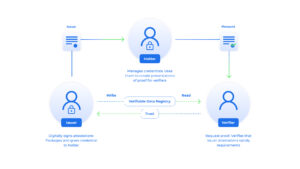 Notably, VCs are inherently more secure than traditional credentials, such as physical driver’s license, because digital signatures make them tamper-resistant and instantaneously verifiable. Moreover, VCs are digital, portable and reusable, which cuts cost and makes everything much more convenient for users.
Notably, VCs are inherently more secure than traditional credentials, such as physical driver’s license, because digital signatures make them tamper-resistant and instantaneously verifiable. Moreover, VCs are digital, portable and reusable, which cuts cost and makes everything much more convenient for users.
However, as much as SSI offers users true ownership of identity data, it also poses challenges in regards to privacy and compliance when activating the data through presentations for verifiers, backup and storage.
In its current form, SSI does not have strong enough privacy when activating the data through presentations because once a VC has been presented to a verifier, regardless of using privacy features such as selective disclosure and zero-knowledge proofs, the data rest with the verifier in a black box that users cannot control. How data is handled from there would rely on trusting the verifiers to comply with regulations such as GDPR, potential auditing from authorities, and any specific agreements with the users. Furthermore, there is a lack of frameworks and standards for compliant, provable and transparent data monetization which is needed to encourage mass adoption.
Another major issue with SSI in its current form is that users are only left with two options for backup of identity data that either compromise security or privacy. One option is to backup and store identity data on another piece of self owned hardware resulting in multiple self-sovereign controlled backups. However, in reality, this is not convenient for users and if hardware is lost, so is the data.
The second option, which is by far the most convenient and popular, is to store identity data externally with a third party, such as a cloud service. This way, users will unlikely lose the data itself and can always access it. However, relying on centralized external services can result in compromising privacy and giving up control because there’s little transparency in how data is stored and manipulated.
Another profound problem with SSI in its current state is the reliance on intermediaries, often known as agencies or agents, to establish connections between parties and facilitate the exchange of VCs.
Partisia Blockchain has as the world’s first L1 operationalized MPC for general computation on a public blockchain, which means that one or multiple data sources can allow others to compute on the data while it stays encrypted and operate under predefined rules expressed in smart contracts. This is also known as confidential compute and several privacy enhancing technologies (PETs) share this capability. However, MPC is superior when computing on multiple inputs and quantum resistance is a hard requirement.
Confidential compute opens up an ocean of new use cases such as private voting, RWA ownership verification, supply chain provenance, GDPR compliant data analytics across multiple data silos, and very importantly for this article enhanced and complete privacy in SSI.
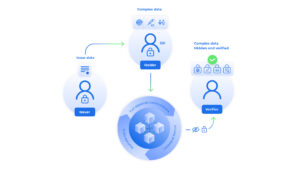
Partisia Blockchain and its MPC capabilities allows a user with an identity wallet to encrypt identity data with secret sharing encryption and then share it with a network of MPC nodes that will not be able to read the original data because the secret shards are distributed amongst the network. There is simply no way to reconstruct the secret and read the original data unless individual secret shards are collected based on a threshold, which is protected by MPC and a collateralized non-collusion security model. Furthermore, secret sharing encryption is by default quantum resistant, so it is not possible to brute force a secret with a supercomputer unlike other PETs like fully homomorphic encryption (FHE) that relies on public key encryption.
This also means that MPC allows for users to have data stored in a “self-sovereign” external network which can function as back-up or simply storage, but more importantly, a private SSI platform to activate the data against a verifier’s request through private verifications and standard privacy features. Partisia Blockchain natively supports multiple standards and can produce presentations for private verification, but also across private and public blockchain for various purposes.
Private verification is really what sets MPC enhanced SSI apart from the current SSI e.g. during the recent pandemic, many attempts were made to create a Covid-19 passport so citizens could prove they were either vaccinated or tested negative while preserving privacy in the claim. Zero-knowledge proofs are good for this, but limited to only presenting yes/no results to a verifier without extensive physical verification, such as ID cards, which would compromise SSI principles.
In collaboration with HES-SO Valais-Wallis, Partisia Blockchain developed a solution where identification is reduced to matching an individual’s face with an image of the person’s face powered by MPC in order to increase security and privacy. The Partisia Blockchain ensures trustworthy information is broadcasted to the verifier and MPC ensures that the private information about the citizen is used only for matching and kept hidden for the verifier.
While MPC is powerful for verification, the idea about having identity data in a private secure network is also useful for use cases that revolves around private AI, e.g. identity data can remain encrypted while a private AI model compute on it and only when the user received the output it can be decrypted incl. the result from the AI model.
Very significant for the above solutions is that the agency is left out so the secure connections and data presentations are managed directly from the MPC clusters where the data privacy is protected and data managed completely on the users’ terms.
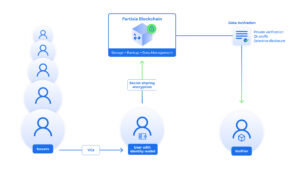
As aforementioned, MPC is powerful when it comes to computing on multiple inputs while preserving privacy. This unlocks a massive potential for compliant and private data analytics on multiple users data combined for use cases such as healthcare data for pharmaceutical R&D and data aggregations for monetization where users are rewarded, but didn’t give up privacy.
The concept is the same as for a single user data where secret sharing encryption is performed and the secret shards are distributed to MPC clusters. However, for multiple users the MPC nodes are able to combine and compute on the data while never understanding the complete input and share encrypted outputs which can only be decrypted and understood by selected users as predefined in zk smart contracts.
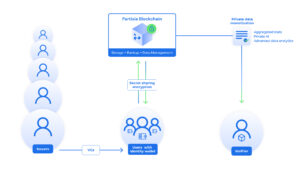
DID/SSI is a large stack of different technologies and this article has only covered how to enhance SSI which is the lacking component to offer compliant end-to-end solutions on top of the existing stack. Together with our partners, we are also building out a significant amount of the fundamental DID/SSI component such as agency, mobile SDKs, identity wallets, standards, DID method, DID resolvers, onchain DID documents, definitions and schemas, trusted registries and more.
Reach out to us for a conversation and learn more about our technologies.
Stay updated: Website • X • Discord • Telegram • LinkedIn • Facebook • Instagram • GitLab • Medium • YouTube
The following are the requirements and step by step process of how to bridge tokens into the Partisia Blockchain network.
Remember that in the Partisia Blockchain, other liquid tokens are used to pay for gas. To transact in the network, you need to bridge the supported tokens first.
For more detailed description of the steps, please review further below or watch the video:
Step 1: Go to https://browser.partisiablockchain.com and sign in using your MPC wallet
Step 2: After you sign in, choose “My account” on the left side and then choose BYOC
Step 3: Choose the token you wish to bridge and select Deposit (or withdraw to withdraw your tokens) Then sign into Metamask
Step 4: Enter the amount you wish to bridge and click on “Deposit”
Step 5: Sign the transaction in metamask and complete the transfer
If you run into any issues, please request for help in our community channels or submit a ticket in Discord.
Thank you for being a part of our community!
Website • Twitter • Discord • Telegram • LinkedIn • Facebook • Instagram • GitLab • Medium • YouTube